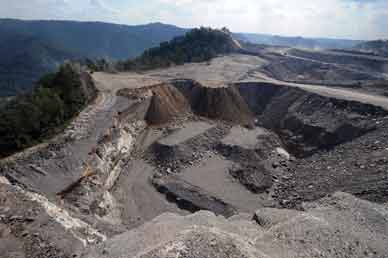Watch the video about tuna fisheries ruining the local environment in Papua New Guinea (PNG), and then sign the petition at Save the Rainforest.
Thursday, October 15, 2009
Tuesday, October 13, 2009
Coal pollution goes from air to water
 In a long article yesterday in the New York Times, Cleansing the Air at the Expense of Waterways, Charles Duhigg writes about how coal pollution is being moved from scrubbed smokestacks to waterways.
In a long article yesterday in the New York Times, Cleansing the Air at the Expense of Waterways, Charles Duhigg writes about how coal pollution is being moved from scrubbed smokestacks to waterways.So three years ago, when Allegheny Energy decided to install scrubbers to clean the plant’s air emissions, environmentalists were overjoyed. The technology would spray water and chemicals through the plant’s chimneys, trapping more than 150,000 tons of pollutants each year before they escaped into the sky.I have to quote Gwen Ifill on this one: "What were they thinking?" Who in their right mind would authorize this pollution dump? Regulators are looking the other way, it seems. We spent so much energy fighting water pollution for years, but now that environmentalists' attention has turned to energy, there is apparently less attention being paid to the pollution of energy, other than its airborn effects.
But the cleaner air has come at a cost. Each day since the equipment was switched on in June, the company has dumped tens of thousands of gallons of wastewater containing chemicals from the scrubbing process into the Monongahela River, which provides drinking water to 350,000 people and flows into Pittsburgh, 40 miles to the north.
Yet no federal regulations specifically govern the disposal of power plant discharges into waterways or landfills. Some regulators have used laws like the Clean Water Act to combat such pollution. But those laws can prove inadequate, say regulators, because they do not mandate limits on the most dangerous chemicals in power plant waste, like arsenic and lead.Although the plant in the picture in Hatfield’s Ferry, PA, claims to have used high tech methods to remove toxic materials, which it then is hoarding in a lagoon with an impermeable membrane,
The plant’s water treatment facility ... does not remove all dissolved metals and chemicals, many of which go into the river, executives concede. An analysis of records from other plants with scrubbers indicates that such wastewater often contains high concentrations of dissolved arsenic, barium, boron, iron, manganese, cadmium, magnesium and other heavy metals that have been shown to contribute to cancer, organ failures and other diseases. Company officials say the emissions by the plant will not pose health risks, because they will be diluted in the river. (My italics)But the toxics go down river - to Pittsburg, into the Ohio, the Mississippi and ultimately the Gulf, which is already suffering from toxic runoff from mid-western farms.
Obviously the only solution is to ban coal. But it won't be easy, of course.
In 2000, Environmental Protection Agency officials tried to issue stricter controls on power plant waste. But a lobbying campaign by the coal and power industries, as well as public officials in 13 states, blocked the effort. In 2008 alone, according to campaign finance reports, power companies donated $20 million to the political campaigns of federal lawmakers, almost evenly divided between Democrats and Republicans.In my humble opinion, the coal industry should be using that money to clean up its act. Or required clean-up measures should be so high, that the costs of its externalities get added to the cost of burning coal. Coal is only cheap today because the coal and energy companies are letting others pay for their pollution, as cancer, asthma, toxic groundwater, dead and ruined waterways, etc. etc.. At some point, their lobby money won't work anymore. When you get too outrageous, even your paid loyalists will turn against you.
This is just one more reason to move to renewables as soon as possible!
Friday, October 2, 2009
Maria's Neighborhood and Mountaintop Removal
This video says it all
Thursday, October 1, 2009
There are still mountaintops being removed
 Just because the EPA has declared that all pending mountaintop removal projects are in violation of the Clean Water Act and must be reviewed further doesn't mean mountaintop removal is vanquished. For one thing, the projects are being reviewed with the companies to see if there is an acceptable solution; they aren't canceled. For the other, there are lots of permits being used right now. The Nation has an article by Jeff Biggers about The Coalfield Uprising which tells a lot more. Here's a short quote:
Just because the EPA has declared that all pending mountaintop removal projects are in violation of the Clean Water Act and must be reviewed further doesn't mean mountaintop removal is vanquished. For one thing, the projects are being reviewed with the companies to see if there is an acceptable solution; they aren't canceled. For the other, there are lots of permits being used right now. The Nation has an article by Jeff Biggers about The Coalfield Uprising which tells a lot more. Here's a short quote:For the past few years, ever since a massive twenty-story dragline landed on a ridge near their home, the Webbs had endured twice-daily, bone-rattling explosions and the quasi-apocalyptic storms of coal dust and fly rock that blanketed their home and garden. Lindytown's creeks and mountain hollows no longer exist, and a once-thriving community has been reduced to a ghost town. "It's unreal. It's like we're living in a war zone," Lora Webb told a local newspaper last fall.Recently they gave up and sold their ancestral home to the mining company, Massey Energy, and were given 60 days to get out.
The temporarily homeless Webbs are a stark example that mountaintop removal does more than "likely cause water quality impacts," as the EPA has determined. More than 3.5 million pounds of explosives rip daily across the ridges and historic mountain communities in West Virginia; a similar amount of explosives are employed in eastern Kentucky, southwestern Virginia and eastern Tennessee. Mountaintop removal operations have destroyed more than 500 mountains and 1.2 million acres of forest in our nation's oldest and most diverse range, and jammed more than 1,200 miles of streams with mining waste.Let us hope that the EPA finally puts a complete stop on those new projects, and begins to look at the old ones as well.
Subscribe to:
Posts (Atom)









